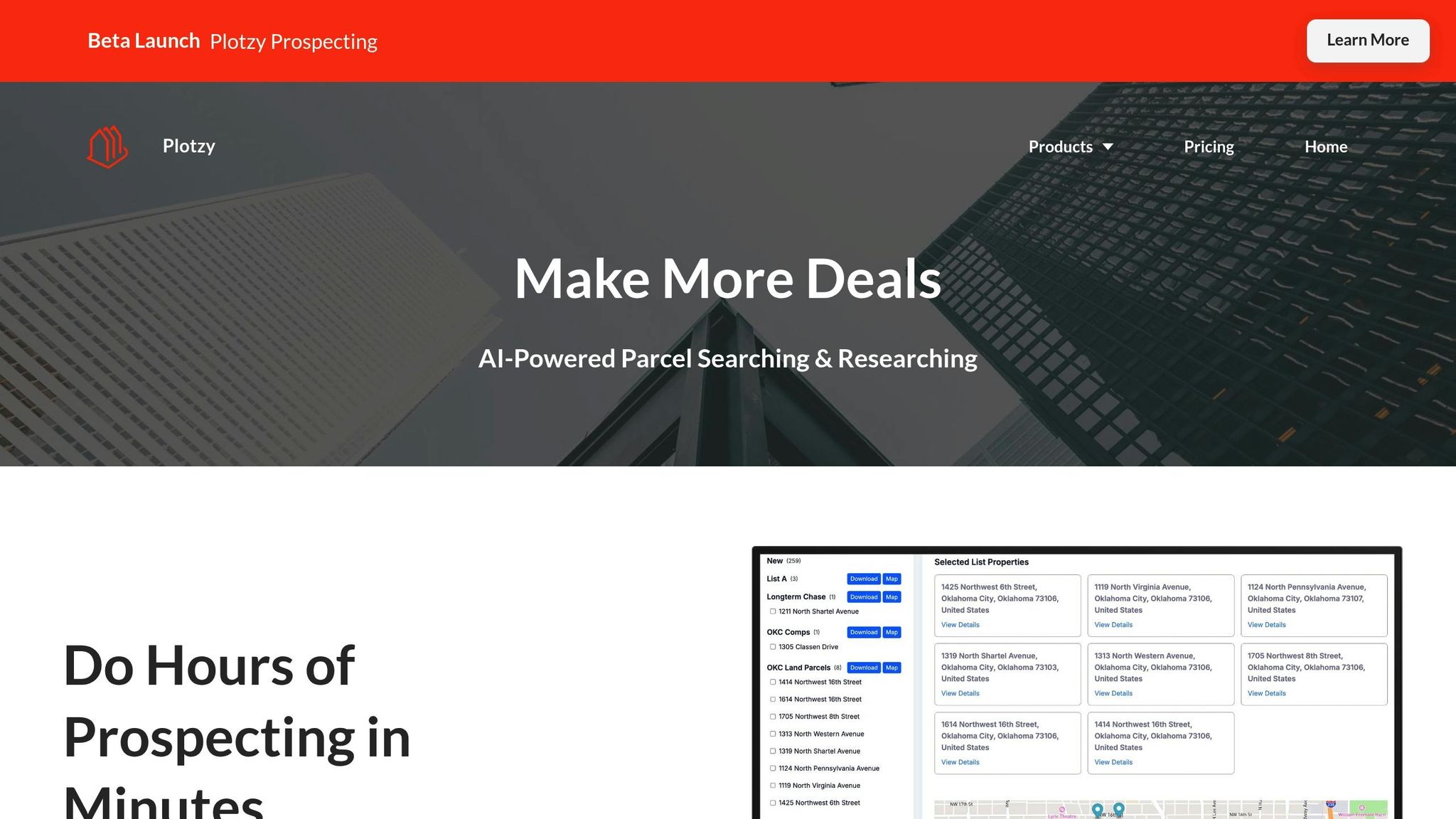Zoning laws define how land can be used, shaping property markets by influencing values, development potential, and investment strategies. Here's what you need to know:
- Zoning Basics: Local laws determine land use (residential, commercial, industrial, etc.), density, building height, and setbacks.
- Property Segmentation: Real estate is categorized by zoning type, influencing investment potential and tenant markets.
- Key Effects: Zoning affects property values, financing options, and community structure. For example, single-family zoning dominates U.S. cities, contributing to housing shortages.
- AI Tools: Platforms like Plotzy simplify zoning research, offering faster insights into zoning codes, property data, and market trends.
Zoning isn't just about rules - it directly impacts real estate decisions and market dynamics. AI tools now make navigating these complexities faster and more efficient.
How to Get Your DEVELOPMENT Project APPROVED: Guide to Zoning, Land Use, and Entitlements!
Zoning Types and Property Market Effects
Zoning laws play a major role in shaping property markets, directly influencing property values, development potential, and investment opportunities. Here's a closer look at the main zoning types commonly seen across the U.S. and how they affect real estate markets.
Common Zoning Classifications in the U.S.
Residential zones are the cornerstone of many American neighborhoods, governing housing developments like single-family homes and apartment complexes. These zones regulate density, building heights, lot sizes, setbacks, and parking requirements. For instance, in San Jose, 94% of residential land is zoned for detached single-family homes. Similarly, cities like Los Angeles, Seattle, and Charlotte allocate 75% to 84% of residential land for the same purpose. Even in dense cities like San Francisco and Washington, DC, over a third of residential space is reserved for single-family homes.
Commercial zones are designated for businesses, retail spaces, and other income-generating developments. Properties in these areas often carry higher values due to their revenue potential.
Industrial zones focus on manufacturing, warehousing, and other industrial activities. While these areas can provide solid returns, they may also negatively impact nearby residential property values because of noise and traffic concerns.
Agricultural zones are designed to protect farmland and limit urban sprawl. However, these zones generally have lower property values compared to those with more development potential.
Mixed-use zones are gaining traction by allowing a combination of residential, commercial, and sometimes industrial uses within the same area. This zoning type encourages walkability, reduces reliance on cars, and fosters vibrant neighborhoods.
How Zoning Shapes Property Market Categories
Zoning regulations dictate what can be built, how dense developments can be, and how accessible properties are. For example, residential zones typically have lower property values since they lack the income potential of commercial zones. On the other hand, areas with flexible zoning that support high-density projects often see increased property values.
Density restrictions, such as height limits and setback requirements, can shrink the developable area of a property, reducing its potential value. The U.S. is particularly reliant on single-family zoning, with 75% of land in many cities reserved exclusively for this purpose. Compared to other nations, this approach creates artificial scarcity in housing markets.
"Class- and race-based exclusion was a conscious rationale of building and land-use regulation from its very first days. It was not its only rationale, but it was an important one." - Fischler
These restrictive practices contribute to the housing shortage. As of 2021, the U.S. faced a deficit of 5.5 to 6.8 million housing units, with zoning and land-use regulations adding approximately 24% to single-family home construction costs and 40% to multifamily homes.
Real-World Examples of Zoning's Impact on Property Values
Several cities illustrate how zoning - or the lack of it - affects property markets.
Houston, Texas, for example, has no zoning laws. This flexibility has led to a construction rate 14 times higher than cities like San Jose. In 2019, Houston built as many apartments as Los Angeles, despite having a smaller population. Reforms in 1998 also allowed the construction of over 25,000 townhouses, mainly in urban areas.
Minneapolis, Minnesota eliminated single-family zoning and off-street parking minimums to encourage mixed-use and affordable housing. Between 2018 and 2021, permits for small apartment buildings doubled, although the total housing units added remained modest compared to the city’s overall needs.
Other cities have introduced targeted zoning reforms. Cincinnati, Ohio reduced minimum lot sizes and setbacks for infill development. Grand Rapids, Michigan eased parking requirements, allowed accessory dwelling units in all zones, and reduced minimum lot sizes. Meanwhile, Buffalo, New York overhauled its zoning in 2017, becoming the first major U.S. city to eliminate minimum parking requirements citywide. This change was part of the Buffalo Green Code, developed through nearly seven years of community input.
Zoning restrictions also have financial consequences. In 2021, home prices grew nearly 20%, while rents surged nationwide. Additionally, 70% of residential areas in major cities either restrict or ban apartments, exacerbating affordability issues. As a result, 48% of rental households are considered cost-burdened.
"Local governments can have antiquated zoning rules and zoning laws. So, they often have an incentive to bring people to the area, but the zoning is behind. The zoning hasn't been updated or changed. Until the legislature changes the zoning itself, the only way to get things done is through a variance process." - Harlan W. Robins, Commercial Real Estate Attorney
These examples highlight how zoning policies shape property values and market dynamics. Mixed-use zoning, in particular, stands out for its ability to improve community engagement and boost property values by creating walkable, livable neighborhoods. For real estate professionals, understanding these trends is essential to making informed decisions in a complex market.
AI Tools for Zoning Analysis and Property Research
Zoning regulations have long shaped the property market, but artificial intelligence (AI) is now changing how these rules are understood and applied. AI is reshaping zoning analysis and property research in commercial real estate, making the process faster, more accurate, and data-driven.
How AI Analyzes Zoning Data
AI simplifies the intricate task of analyzing zoning codes and ensuring compliance. Using machine learning, it processes historical and real-time property data to find patterns and predict investment opportunities. With Natural Language Processing (NLP), AI can transform unstructured text - like property listings, zoning ordinances, and market reports - into structured, actionable insights. This means AI can quickly identify zoning changes that might influence long-term investment strategies.
Predictive models powered by AI dig into datasets covering population growth, economic trends, and migration patterns to forecast real estate demand. These tools also help optimize land use, minimize urban sprawl, protect natural spaces, and pinpoint areas where affordable housing is needed most.
Additionally, AI can analyze thousands of property listings, title documents, and inspection reports at once, pulling out critical details and identifying compliance issues more efficiently than manual methods.
AI Benefits for Property Segmentation
AI offers a major edge over traditional research methods by analyzing vast amounts of market data - such as economic indicators, demographic shifts, and local development plans - to highlight profitable investment opportunities. Since AI bases its analysis on objective data, it delivers more precise property valuations, avoiding the subjective bias that can affect human assessments.
By automating repetitive tasks, AI frees up real estate professionals to focus on higher-value activities. What used to take days of zoning research can now be completed in minutes, saving time and resources. AI also enhances accuracy by processing massive datasets, offering insights into market trends, risks, and investment opportunities that would otherwise be missed. For example, AI-driven simulations can predict traffic impacts, environmental effects, and economic benefits, giving stakeholders data-backed projections to make faster, more informed decisions.
AI even helps uncover off-market opportunities by identifying properties with favorable zoning characteristics before they’re publicly listed, giving investors a competitive advantage.
"AI is helping to streamline our industry. As venture capital investors, we have seen many experiments with the latest AI capabilities, and the key to making the leap from pilots to successful products hinges on data quality, workflow integration and intuitive output interfaces." - Raj Singh, Managing Partner, JLL Spark
A compelling example of AI's impact is Royal London Asset Management. By adopting JLL's AI-powered Hank technologies, they achieved a 708% ROI and 59% energy savings in a commercial office building, reducing carbon emissions by up to 500 metric tons annually. This demonstrates how AI insights can directly enhance property segmentation strategies, connecting technological innovation with market needs.
How Plotzy Simplifies Zoning Research

Platforms like Plotzy take these AI-driven advancements and make them accessible for professionals. Plotzy’s AI-powered tools are designed to simplify zoning research for brokers, developers, investors, and land acquisition teams. By allowing users to filter and search for parcels based on zoning and property criteria, it streamlines the site selection process.
With its zoning-based parcel search, Plotzy enables users to instantly find properties that meet specific zoning requirements. This eliminates the need for time-consuming manual map reviews, which is especially helpful for developers targeting properties for particular project types.
Plotzy also automates owner contact information retrieval, making it easier to connect with property owners directly. This feature removes the hassle of digging through public records or cross-referencing databases, saving professionals valuable time.
Another standout feature is the platform’s ability to generate comprehensive reports. These reports combine zoning, property, and market data into essential due diligence documents, which are a critical part of commercial real estate transactions. A solid zoning report includes interpretations of ordinances, variance searches, conformance checks, and details on parking and setbacks.
"We leverage artificial intelligence to enhance productivity, explore creative options in planning and visualization studies, and optimize internal workflows. By integrating AI, we are not only improving our operational capabilities but also increasing the quality and value of solutions for our clients." - Dan DeWeese, Senior Associate at Lankford & Giles
With 81% of real estate development companies planning to prioritize data and AI technology investments by 2025, according to Deloitte’s Real Estate Outlook survey, platforms like Plotzy are becoming indispensable for staying competitive in the rapidly evolving commercial real estate industry.
sbb-itb-11d231f
Municipal Zoning Information and Research Methods
Municipal zoning is a local affair, with regulations varying significantly from one region to another. Knowing how to navigate these systems and incorporate zoning data into your property research can open up valuable opportunities in commercial real estate.
Finding Zoning Codes and Maps
The first step in understanding zoning is to contact your local zoning office for accurate information. Many municipalities now provide interactive zoning maps online, which can make it much easier to get answers to zoning questions. William J. Trask Jr., GIS Project Manager at Fisher Associates, emphasizes the value of these tools:
"MapLink accelerates access to zoning codes, supporting quicker planning decisions."
Jill Dix, Town Clerk in Holland, NY, also highlights the benefits of digital access:
"(MapLink) cuts down on … phone calls with realtors, developers and contractors and other people who want answers to zoning questions."
If the zoning data you need isn’t available on standard platforms, open data portals like Socrata can be a helpful resource. For example, some cities allow you to download zoning information as shapefiles, which can then be uploaded into mapping platforms. UrbanFootprint has demonstrated how powerful this can be - supporting a New York Times study by mapping zoning codes to analyze the extent of single-family zoning in cities across the U.S. With UrbanFootprint, users can start projects anywhere in the country and generate parcel or census block land-use maps.
Once you’ve gathered accurate maps and zoning codes, the next step is to integrate this information into your broader property research.
Adding Zoning Data to Property Research
Zoning maps and bylaws are both essential for thorough property research. While maps show the boundaries of zoning districts, bylaws outline the rules - such as permitted uses, dimensional restrictions, and design requirements - within those districts. Start by obtaining both the zoning map and its accompanying bylaws from the municipality.
Zoning systems often involve a combination of base districts and overlay districts. Base districts apply to the entire municipality, while overlay districts add extra layers of regulation or flexibility. This layered approach can create a patchwork of rules, so it’s critical to determine whether a proposed use is "by right" (not requiring additional review) or if it involves discretionary processes like special permits, which can complicate matters.
The complexity of zoning is well illustrated by the Metropolitan Area Planning Council's (MAPC) Zoning Atlas. This atlas covers nearly 2,000 zoning districts in Greater Boston, with data from 56 municipalities and 260 overlay districts. According to the Atlas:
"Zoning is the DNA of a community's land use. It doesn't determine everything, but it's an underlying, coded blueprint for change, or sometimes the lack thereof."
When zoning regulations seem ambiguous or overly complex, reaching out to municipal staff for clarification can be crucial. This kind of layered zoning data also supports advanced property segmentation, especially when paired with AI-driven tools.
Finding Off-Market Deals with Zoning Data
Zoning data isn’t just for understanding regulations - it can also help uncover hidden opportunities in off-market properties. By combining zoning data with other spatial datasets, investors can identify properties with untapped potential for rezoning or redevelopment [33, 36]. Real-time land intelligence platforms make this process even more efficient, helping investors streamline site selection, discover off-market opportunities, and shorten acquisition timelines. Overlaying zoning laws with additional factors like flood zones, infrastructure, and regional variables (e.g., schools, easements, and construction costs) provides a more comprehensive picture.
One notable example comes from the Czech Republic, where CleverMaps digitized town zoning plans and connected them with spatial data on population density, road networks, and utility access. This approach allowed for efficient site identification using a consistent data model.
Integrated zoning data can also support sustainable development. Research shows that focusing growth in urbanization zones could save nearly 4,200 hectares of grassland and cropland from overbuilding. Even shifting growth to areas without urbanization projects could save 3,800 hectares.
Platforms like Plotzy take this a step further by combining zoning research with owner data and detailed reports, making it easier to move from analysis to action.
Conclusion: Zoning's Role in Property Segmentation and AI Tools
Key Points
Zoning regulations play a crucial role in shaping property segmentation across the U.S., with far-reaching financial effects. For instance, zoning variances or reclassification can increase property values by as much as 20–50%. Commercially zoned properties often carry higher market values than residential ones, thanks to their potential to generate income. Even within residential zoning, the rules have a significant impact - strict residential zoning can preserve tranquil, family-friendly areas, boosting property appeal, while high-density zoning tends to enhance market potential.
Recent legislative shifts highlight how quickly zoning landscapes can evolve. In 2023, Washington State passed House Bill 1110, mandating many cities to permit "middle housing" on lots previously restricted to single-family use, which has already led to notable value increases. Similarly, Minneapolis eliminated single-family-only zoning, signaling a broader trend toward more flexible land use.
AI tools are transforming how real estate professionals navigate these zoning complexities. Platforms like Plotzy streamline tasks such as zoning-based parcel searches, retrieving owner contact details, and generating reports. These capabilities empower professionals to act strategically and efficiently in a rapidly changing environment.
Next Steps for Real Estate Professionals
Given these developments, real estate professionals need to adapt their strategies to thrive in an evolving zoning landscape. A deep understanding of zoning classifications and potential changes is now critical. Before making any investment decisions, professionals should conduct thorough research into current zoning laws and consult with experts like real estate attorneys, urban planners, and local government officials.
Staying updated on community plans and zoning proposals is equally important, as these can significantly impact land use and property values. For example, mixed-use developments - designed to create walkable, all-in-one neighborhoods - are becoming increasingly popular and can drive up property values in certain areas. This trend is reshaping urban environments at a rapid pace.
AI tools like Plotzy offer a clear edge by combining zoning information with robust property data. The platform simplifies the process of analyzing zoning impacts, identifying property opportunities, and acting on insights quickly. Real estate professionals who leverage such tools can transition seamlessly from research to actionable strategies.
Ultimately, success in this market hinges on the ability to navigate zoning complexities while spotting opportunities others may overlook. Embracing AI-powered tools isn’t just about staying competitive - it’s about gaining the insights needed to make smarter, faster decisions in an increasingly intricate real estate landscape.
FAQs
How do zoning laws affect property values and investment opportunities in different areas?
Zoning laws significantly influence property values and investment potential by dictating how land can be utilized and developed. For instance, properties located in areas designated for commercial or mixed-use purposes often command higher market values. Why? Because they offer greater business opportunities and access to nearby amenities. Meanwhile, residential zones tend to provide steadier environments but usually come with lower property values.
When zoning regulations are more flexible, they can boost a property's appeal by opening the door to a variety of development possibilities, which may lead to increased value. On the flip side, stricter zoning rules can curb growth opportunities, making properties less enticing to investors. Grasping the ins and outs of zoning laws is key to spotting lucrative opportunities and making smart real estate decisions.
How does AI make zoning analysis and property research easier?
AI simplifies zoning analysis and property research by automating the handling of intricate datasets, including zoning codes, property records, and environmental data. This automation cuts down the time and effort needed to interpret regulations and spot opportunities.
It also provides insights such as property value estimates, potential investment prospects, and zoning compliance risks with improved precision. With AI, real estate professionals can make quicker, data-informed decisions and streamline tasks like site selection and municipal research.
How can zoning data help real estate professionals uncover off-market opportunities and make smarter investment choices?
Zoning data is a game-changer for real estate professionals looking to uncover off-market opportunities and make smarter investment choices. By diving into zoning maps and regulations, they can identify properties ripe for development, redevelopment, or rezoning - hidden gems that aren't actively listed.
With the help of AI-powered tools, this process becomes even more streamlined. These tools allow users to filter properties by zoning criteria, access in-depth property details, and spot emerging trends. Armed with these insights, brokers, investors, and developers can stay ahead of the curve, securing deals before the competition and boosting their investment returns.


